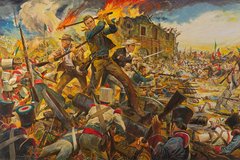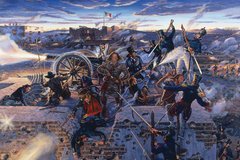Disposal of bodies during the Texas Revolution was a problem faced by both the Mexican and Texan armies. Following the Battle of the Alamo and the Goliad Massacre, the Mexican troops burned the bodies of the slain Texans. Following the battle of San Jacinto, Sam Houston made no provisions to dispose of the Mexicans troops killed in the battle and the corpses remained where they lay. Unfortunately for one Texas woman, Margaret “Peggy” McCormick, the decomposing bodies were lying on her property.
Peggy McCormick was born in Ireland in approximately 1788 and immigrated to Stephen F. Austin’s colony with her husband Arthur McCormick and their two sons around 1823. The couple was granted a league of land on the south side of Buffalo Bayou at the junction of the bayou and the San Jacinto River. Arthur died in 1824 leaving Peggy to manage the land with the help of her sons.
In April of 1836, as the Mexican Army was advancing across Texas, Peggy and her sons fled from their land as part of the Runaway Scrape. When they returned a few days after the Battle of San Jacinto, the family found that not only was their corn crop and livestock — more than 230 animals — gone, consumed by both the Mexican and Texan armies, but that their property was littered with the bodies of hundreds of Mexican soldiers. The sight was one that Peggy said would haunt her for the rest of her life. Horrified by the state of her home, Peggy traveled to Sam Houston’s camp to demand that he remove the rotting, smelling corpses.
Houston refused to move the bodies, and instead tried to impress upon McCormick the significance her land now held as the site of Texas independence. McCormick, unimpressed with Houston’s blustering, replied, “To the devil with your glorious history! Take off your stinking Mexicans.” Houston again refused. According to Robert Hancock Hunter, Houston wanted to make Santa Anna bury the bodies but he would not do so. With no other choice, Peggy McCormick and her two sons buried the bodies themselves.
Peggy continued to live her property, growing it to one of the largest cattle operations in Harris County. Unfortunately, most of her land was stolen from her through an unscrupulous land resurvey that was not uncovered until after her death in 1854. Houston’s words to Peggy McCormick, that her land would become a historic site well remembered for its role in Texas history was prophetic. Today the site is part of the San Jacinto Battleground State Historic Site. One of the lakes on the property was renamed “Peggy’s Lake” in honor of this remarkable Texas woman.
Image above: Close up view of The Battle of San Jacinto by Henry Arthur McArdle, Prints and Photographs Collection, Archives and Information Services Division, Texas State Library and Archives Commission.


